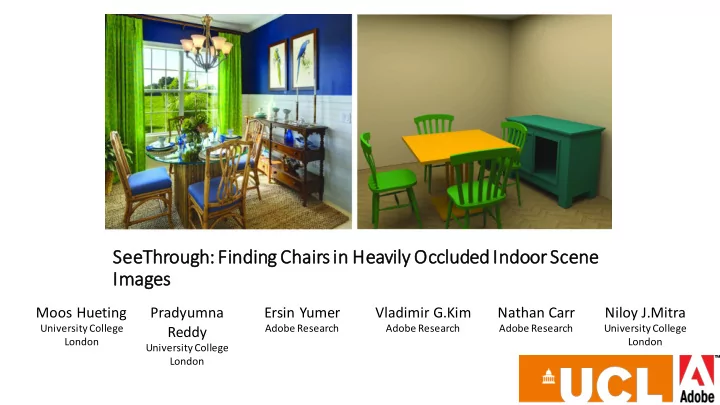

SeeTh Throu ough: Findin inding Cha hair irs in Heavily ily Occlud luded d Ind ndoor or Scene ne Images Moos Hueting Pradyumna Ersin Yumer Vladimir G.Kim Nathan Carr Niloy J.Mitra University College Adobe Research Adobe Research Adobe Research University College Reddy London London University College London
Goal : extract 3D scene mock up from single image (focused on chairs and other highly occluded objects)
Context is Important
Context is Important
Pipeline
Pipeline
Pipeline
Pipeline
Pipeline
Pipeline
Pipeline
Keypoint estimation
Keypoint Dataset Input image Objectnet3D Ground truth annotation Selecting Vertices of the overlaid CAD model cvgl.stanford.edu/projects/objectnet3d/
Keypoint thresholding
Keypoint thresholding
Pipeline
Vanishing point estimation
Pipeline
PCA template
Fit parameters
Candidate Set
Pipeline
Candidate selection Unary Costs: measure how well the key points explain the object Pairwise Costs: Capture relationship between objects
Relative transform Relative Rotation Relative Translation
Candidate selection
Pipeline
Results http://geometry.cs.ucl.ac.uk/projects/2018/seethrough/
Results and Dataset http://geometry.cs.ucl.ac.uk/projects/2018/seethrough/
Results and Dataset http://geometry.cs.ucl.ac.uk/projects/2018/seethrough/
Results Real World Images Im2CAD Ours SeeingChairs http://geometry.cs.ucl.ac.uk/projects/2018/seethrough/
Results Real World Images Im2CAD Ours SeeingChairs http://geometry.cs.ucl.ac.uk/projects/2018/seethrough/
Results Real World Images Im2CAD Ours SeeingChairs http://geometry.cs.ucl.ac.uk/projects/2018/seethrough/
Performance comparison
Goal : extract 3D scene mock up from single image (focused on chairs and other highly occluded objects) Main insight : cases with significant occlusion can be improved by using high- level contextual knowledge about how scenes “work” Main result : resulting scene mock ups significantly better than combinations of state-of-the-art methods which are reliant on object detection algorithms.
Limitations • First, we plan to extend the evaluation to more classes of objects beyond those considered. • Second, one can explore higher fidelity models to better recover fine scale features in the recovered models. • Finally, we would like to explore templates that can express a broader understanding of the multi-object spatial relationships including symmetry and regularity.
Acknowledgement This work is in part supported by the Microsoft PhD fellowship program, and ERC Starting Grant SmartGeometry (StG-2013-335373). Also, special thanks to Aron Monszpart, James Hennessey, Carlo Innamorati, Paul Guerrero, and other group members for invaluable help at various stages of the project.
Thank You Code available: geometry.cs.ucl.ac.uk/projects/2018/seethrough/paper_docs/Code_Data.zip
Recommend
More recommend